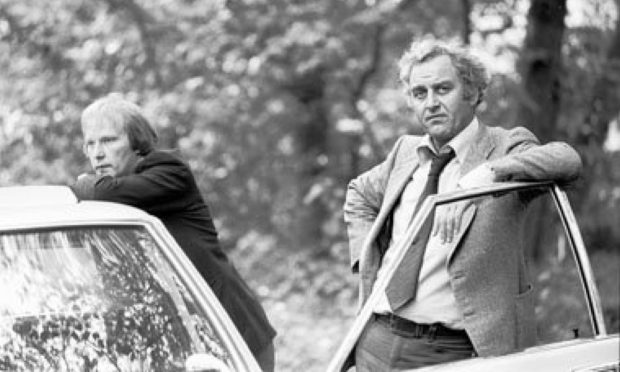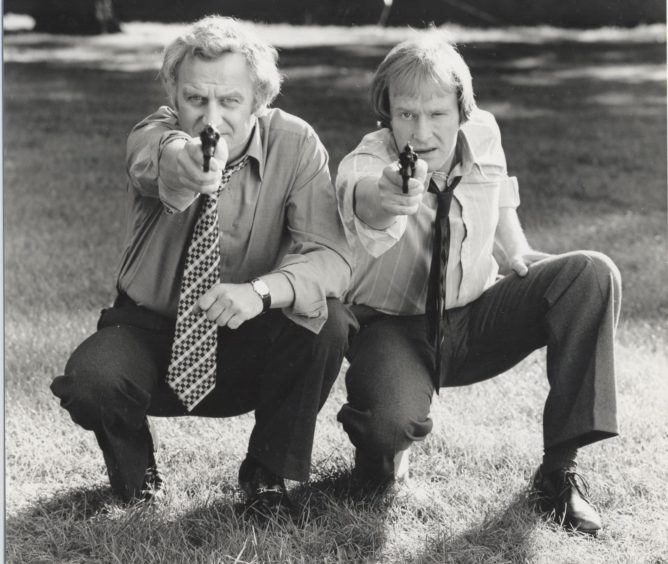A tall, grim-faced detective pushed forward and stared at us with a snarl creeping across his face.
“Right, strip off. We need your clothes, shoes first,” he ordered.
“This is now a crime scene and your clothes are required to be examined forensically.”
He reminded me of Flying Squad detective Jack Regan from The Sweeney cop drama, which was huge on television at the time.
Shoes and jackets were off and we begged their pardon; I worried how far this was going as I was wearing my Superman boxers and we were standing outside in a garden.
I loosened my tie, but not the one pictured under my chin in my byline photo, I hasten to add.
I only mention this because an eagle-eyed reader said I was wearing the same tie in a picture of me in last week’s column taken a quarter of a century ago. Funny, but not true – both ties were flowery, but different colours. Something blossomed from his observation, though: he showed I was boringly predictable in my tie style.
Mercifully, before the undressing could go any further the detective bawled out again: “Now pick up your stuff, clear off and don’t do that again.”
Or words to that effect, although as I recall he used far more industrial language.
There were some guffaws as we shuffled away sheepishly.
Policing (both factual and fictional) has changed
Two young reporters were taught a lesson, but we kind of respected it. It was part of the cut and thrust of the times, I suppose.
Fate put us in the wrong place at the wrong time rather than deliberately interfering with a police investigation. I wandered into a seemingly deserted property with my sidekick Arthur after being tipped off that there was a major incident in the vicinity.
We had no way of knowing at the time that a body had been found and it looked like murder.
We also failed to notice that while we were at the back, police were gathering at the front. Suddenly there was a commotion and we were surrounded.
We unwittingly overstepped the line, but they were also sailing pretty close to it for a few moments.
These days one of us would have filmed it on our mobile phone, possibly igniting a social media outcry about heavy-handed police. Somebody would have organised a protest in a jiffy.
If we ended up starkers in a back garden in Line of Duty, you could imagine officers being hauled in to explain themselves. But no one would have batted an eyelid in the swashbuckling Sweeney 30 years earlier.
Softly, softly or heavy-handed?
I suppose it’s all about how far you push it: do you stand your ground or accept authority? Public and police have far-reaching choices to make about challenging or enforcing the law.
I thought of my embarrassing escapade after the north-east’s police chief raised fears about stand-offs and general public belligerence when officers enforced lockdown rules.
One half of me longed for the police to get stuck in and sort these people out. But I also cherish the softly, softly consensual style of policing we have in the UK. That is what makes it so different.
I hope police still value this, too, but it is a tricky tightrope on which society balances.
The dilemma was brought into focus graphically by violent scenes at the Clapham Common vigil after Sarah Everard’s recent death.
We are lucky we can have strong opinions and hold our police to account. But we must preserve sensible boundaries to protect our democracy
But in other high-profile examples, peaceful protest has turned to violence as a hardcore element revels in a showdown with police at all costs. The original point of the protest is corrupted.
It seems pre-ordained that some throw themselves into a confrontation as martyrs, begging police to carry them off with a bloodied head. And the police oblige as commensurate force is lawful, however shocking it might appear.
What is the alternative – to let lunatics start running the asylum?
We don’t know how lucky we are
Alex Salmond’s strategy for reinforcing a potential separatist “supermajority” in Holyrood for another referendum includes “peaceful” street protests. If it happens I hope they are trouble free, but in the current climate anything could happen.
And, let’s face it, if I was a pro-independence strategist I would prefer public protest to be angry and shouty at least.
After all, the imagery projected worldwide is meant to portray an oppressed people shackled against our will. But let us keep it in perspective. In other countries people have laid down their lives protesting against real tyranny.
We are lucky we can have strong opinions and hold our police to account. But we must preserve sensible boundaries to protect our democracy.
Some extremists probably think they are already in a police state for not being allowed to attack the police.
But we don’t know how lucky we are: what if we were waking up – or dying –
in Myanmar?
David Knight is the long-serving former deputy editor of the Press and Journal


